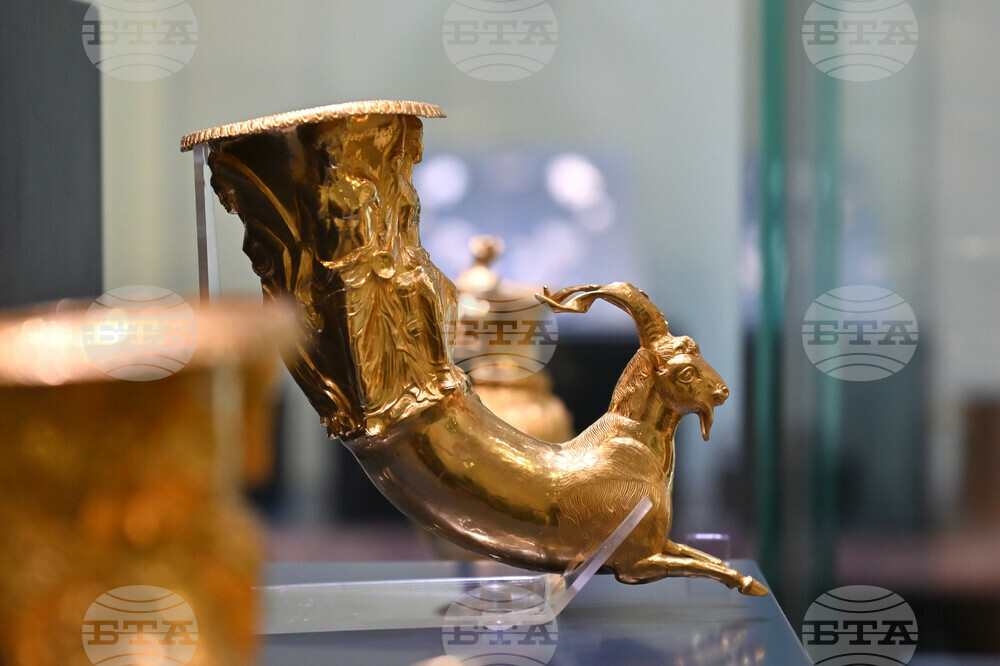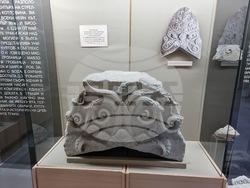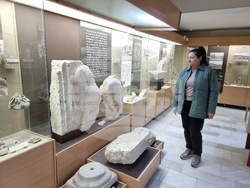site.btaExhibition of Ancient Thracian Treasures from Bulgaria, Romania, and Greece to Be Unveiled in US


The J. Paul Getty Museum in Los Angeles will present the exhibition Ancient Thrace and the Classical World: Treasures from Bulgaria, Romania, and Greece on Sunday. The exhibition, which will be on until March 3, 2025, sheds light on this little-known culture and its interactions with Greece, Persia, and Rome over the course of two millennia (about 1700 BCE-300 CE). To be displayed are over 200 artefacts, including items of gold, silver, bronze, ceramics, stone reliefs and other works of art showing Thrace's links with the other ancient cultures in the Mediterranean and beyond.
Getty Museum Director Timothy Potts describes the exhibition, as quoted by the institution's press service, the first focused on the interrelations and rivalry between the Thracians and their neighbours, particularly Greece and Rome. In his words, for many of the Museum's visitors, that will be the first encounter with the fascinating and highly complex ancient culture, which was both feared for its military skills and cultivated for its rich creativity, especially its silver and gold items. Potts expressed gratitude to the Ministry of Culture of the Republic of Bulgaria and the National Archaeological Institute with Museum at the Bulgarian Academy of Sciences for their partnership in making the exhibition possible, as well as to the other sponsors of the exhibition.
Vice President Iliana Iotova is in LA to open the exhibition.
The Bulgarian exhibits
Fourteen museums from Bulgaria with a total of over 150 objects will take part in the exhibition. Bulgarian objects represent over 90% of all exhibits included in the exhibition.
The greatest number of artefacts were contributed by the National Archaeological Institute with Museum at the Bulgarian Academy of Sciences in Sofia (NAIM-BAS), the Plovdiv Regional Archaeological Museum and the Iskra Museum of History in Kazanlak. Exhibits are also provided by: the regional museums of history in Burgas, Veliko Tarnovo, Vratsa and Lovech, and the Karnobat Museum of History, the National Museum of History, the Ancient Nessebar Museum, the Prof. Mieczyslaw Domaradzki Archaeological Museum in Septemvri, the Strelcha Museum of History, the Sozopol Archaeological Museum and the Regional Museum of History in Targovishte. Emblematic for Ancient Thrace discoveries such as the Valchitran gold treasure, the Panagyurishte gold treasure, the complex of objects from the Golyama Kosmatka mound near the town of Shipka, vessels from the Rogozen treasure and many others are presented. The artifacts included in the exhibition span a period of over two millennia - from the Late Bronze Age (2nd millennium BC) to the time of the Roman Empire - and illustrate the important place of Thrace in the ancient world, NAIM-BAS said in a press release. The world's leading museums have also provided objects from their collections: the Louvre Museum in Paris, the British Museum, the Metropolitan Museum in New York and the Getty Museum itself.
The Iskra Museum of History in Kazanlak will present over 30 moveable cultural artefacts from the symbolic burial of Thracian ruler Seuthes III from the tomb at the Golyama Kosmatka mound near Kazanlak. The golden oak wreath, a golden wine goblet (kylix), a silver jug and phiale, a bronze askos and bronze patera, as well as an amphora for transporting wine and parts of the full set of the ruler's armament, are among the exhibited items.
The earliest-dated find, sent by the museum in Burgas, is a copper ingot in the shape of a stretched ox hide from the late Bronze Age and the early Iron. The selection also includes a fragment of the a Mesembrian decree dating from the late 4th and early 3rd centuries B.C. Local scholars call it the "Decree of Sadala" because it mentions the Thracian dynast, as well as the so-called "Teacher's stele”, a 3rd century BC tomb stele depicting a seated man with an open book looking to the right.
The now popular Apollonia jug is among the items sent by the Archaeological Museum in Sozopol. This provides valuable information about the connection between Thracian and Hellenic civilizations.
Visitors will be able to see a total of nine exquisitely crafted vessels provided by the Regional Museum of History in Vratsa. Two from the Mogilanska Mogila treasure from downtown Vratsa and seven from the Rogozen Treasure. A gilded silver greave and a golden jug with chariots depicted were selected from the former. Along with other gilded objects, the emblematic phiale with Augeas and Heracles and a perfect jug, featuring the Mother Goddess riding a lioness, stand out among the Rogozen Treasure choices.
The Letnitsa Treasure will also be pert od the exhibition. Provided by the Lovech Regional Museum of History, it includes appliques to horse ammunition attached to the halter straps, reins, breast strap, saddle and mane of the horse, as well as an iron bridle. In addition to these, the hoard also contains smaller items - silver gilt eight-leaf rosettes, acorns, a large number of silver tubes, and beads.
The relief of a panther or lion from the Archaeological exposition in Strelcha Historical Museum has also been selected to be part of the exhibits.
The Regional Museum of History in Veliko Tarnovo has contributed a silver kylix with a gilded engraving of the eighth labour of Heracles, involving the Thracian king Diomedes.
Plovdiv Regional Archaeological Museum participates with its three major treasures, one of which is the emblematic for Bulgaria Panagyurishte Gold Treasure. The drinking set consists of nine gold vessels - a phiale and eight rhytons depicting various zoomorphic and anthropomorphic images of mythological characters and scenes popular in Thrace during the Hellenistic era. It weighs 6.1 kg. The treasure belonged to a still unknown Thracian ruler of the Odrysian tribe who ruled in late 4th or early 3rd century BC.
The Valchitran Treasure, the stone stele of Deines and the bronze head of Seuthes III are among the exhibits with which NAIM-BAS is participating in the exhibition.
The Kralevo Treasure from the collection of the Regional History Museum in Targovishte is also part of the exhibits sent by fourteen Bulgarian museums. It consists of grave goods, including decorations of horse ammunition and jewelry (rings and bracelets) with a total weigh of 214 g and dating from the first half of the 3rd century BC.
A marble tombstone of Julia, sitting in a two-wheel chariot and holding two flaring torches, depicted as the goddess of the underworld Hecate, and a marble tablet dating from the 4th century BC with a dedication to Cybele, a goddess popular among both Greeks and Thracians are among the artefacts sent by the Ancient Nessebar Museum.
The inscription from Pistiros, also known as the Vetren inscription, from the collection of the Prof. Mieczyslaw Domaradzki Archaeological Museum in the town of Septemvri is among the exhibits of the fourteen Bulgarian museums.
The Museum of History in Karnobat is participating with its most valuable item - a red-figure jug with the image of Thracian warriors from the 5th century BC discovered in 1996.
The Thracian culture
The ancient land of Thrace lay north of the Aegean Sea, in an area that now comprises Bulgaria and parts of Romania, Greece, and Turkiye, the exhibition's organizers write. The Thracians lived in numerous tribes and were renowned for their skill as warriors and horsemen and for their wealth in precious metals. The Thracians left few written records, and much of what we know today depends on brief, often biased accounts from ancient Greek authors such as Herodotus and Thucydides. Archaeological discoveries made in the region of Thrace since the early 20th century provide firsthand evidence of Thracian history and society. Spectacular grave goods, treasure hoards, and other finds illuminate Thrace’s rich resources and varied artistic achievements, as well as its unique position - geographically, politically, and culturally - between the East and the West.
The ancestors of the Thracians migrated from the Eurasian Steppe and settled in the area of present-day Bulgaria, where a distinctive Thracian culture emerged by the Late Bronze Age (around 1500 BCE). The early Thracians were divided into tribal groups and were known as skilled horsemen and fierce warriors. They had contacts with the Mycenaean Greeks and the people of central Europe, and bronze swords made in Thrace derive from both sources. Local tribes in southern Thrace worked the copper mines, manufacturing a variety of objects and trading copper ingots. Thrace was also rich in gold, and Thracian metalworkers produced highly original vessels, such as the Valchitran Treasure to be displayed in the Getty Museum. Sara E. Cole, co-curator of the exhibition, said that it is a rare opportunity to acquaint the US public with the world of ancient Thrace: a place and culture that deserve much greater attention. The archaeological material on display, ranging from impressive gold and silver to ceramics and tomb monuments, allows the Museum to present Thrace from a Thracian perspective, at times challenging the views expressed by ancient Greek and Roman authors, she noted.
The cultural and political interactions of Thrace with ancient Greece, Persia, and Rome, which formed the history and art of the region, are a main focus of the exhibition. As early as the Bronze Age, Greeks traveled north to Thrace to access its rich deposits of gold, silver, and copper. During the 600s and 500s BCE, Greek settlers - mostly from Miletos in Ionia (present-day western Turkiye) - founded new cities in Thracian territories on the northern Aegean and Black Sea coasts. Greeks also established smaller trading posts inland. The powerful and rapidly expanding Achaemenid Persian Empire reached Thrace in 513 BCE, subjugated various Thracian tribes and leaving a lasting cultural imprint, particularly in the use of gold and silver vessels at lavish banquets. Thrace served as a staging ground for the Persian king Xerxes I’s invasion of Greece in 480 BCE, in which Thracians fought on the Persian side. Centuries later, the Roman Empire expanded its territory to the north of Greece and reached the borders of Thrace. Around 46 CE, Emperor Claudius annexed the region of Thrace as a Roman province called Thracia. The Thracian people increasingly spoke Latin and participated in Roman imperial institutions, but many local cultural traditions, the Getty Museum said.
Who is Getty
J. Paul Getty (1892–1976) was an American oil billionaire reputed to be the richest man in the world at the time of his death, shows information in Britannica. He owned a controlling interest in the Getty Oil Company and in nearly 200 other concerns.
After graduating from the University of Oxford in 1913, Getty bought and sold oil leases near Tulsa, Oklahoma, with the help of his father, George F. Getty, himself an oil millionaire. Young Getty proved to be a gifted entrepreneur and by 1916 had made his first million, at which point he moved his base of operations to California. During the 1920s, having accumulated a substantial fortune, he set about gaining control of several large independent oil companies and began building an immense financial empire. His most lucrative venture was a 60-year oil concession that he obtained in Saudi Arabia in 1949, the profits from which vaulted him into the billionaire class during the mid-1950s.
A man of eccentric personal habits, Getty was married and divorced five times, Britannica reads. After World War II he spent little time in the United States and eventually settled down at Sutton Place, a large estate near Surrey, England. In 1953 he founded the J. Paul Getty Museum, sited on an estate in Malibu, west of Los Angeles, where he displayed many of the art objects that he had accumulated during his life. The museum moved to larger quarters in Malibu in 1974, and Getty, who died in 1976, bequeathed the bulk of his fortune to the museum’s trustees to spend “for the diffusion of artistic and general knowledge.” The Getty Trust became a major philanthropic foundation and built the Getty Center, a cultural complex in Los Angeles that opened in 1997.
Big exhibitions around the world with Bulgaria's participation
Bulgaria has big traditions on which the exhibition at the Getty Museum is based. The Bulgarian News Agency (BTA) has been presenting the upcoming exhibition for three weeks now through daily publications in Bulgarian and English.
Next year, the Bulgarian News Agency will dedicate an issue of its LIK magazine to Bulgarian archaeology, with the exhibition in Los Angeles being its centrepiece.
According to information from the BTA's Reference Department, about 50 such exhibitions with Bulgarian participation have been held over the past 65 years.
Here's a list of similar exhibitions covered by BTA:
1960, Paris (France): Treasures in Bulgarian Museums and Monasteries
1964, Essen (Germany): Treasures in Bulgarian Museums and Monasteries
1974, Paris (France): Thracian Art from the Bulgarian Lands
1978, Germany, Czechoslovakia, Hungary, Austria: Thracian Art from the Bulgarian Lands
1979, Japan, Germany: Thracian Art from the Bulgarian Lands
1980, Geneva (Switzerland): Thracian Art from the Bulgarian Lands
1981, Stockholm (Sweden): Thracian Art from the Bulgarian Lands
1982, Tokyo (Japan): Europe’s Oldest Civilization and World’s Oldest Gold, Varna, Bulgaria
1983, Moscow, Soviet Union: Troy and Thrace
1986, London (UK): New Thracian Treasure of Rogozen
1987, Montreal (Canada): The Gold of the Thracian Horsemen
1988, Geneva (Switzerland): Treasures of Bulgarian Art from VII to XVI Century
1988, Madrid (Spain): Thracian Treasures
1989, Venice (Italy): The Thracians - Art and Culture in Bulgaria from Prehistory to the Late Roman Age
1989, Saint-Germain-en-Laye (France): Mankind’s First Gold
1997, Uppsala (Sweden): Thracian Treasures
2000, Helsinki (Finland): Thracian Treasures from Bulgaria - World and Statehood
2000, Rome (Italy): Treasures of Christian Art in Bulgaria
2004, Vienna (Austria): Thracian Gold
2004, Bonn (Germany): Thracians. The Golden Kingdom of Orpheus
2005, Barcelona and Madrid (Spain): Thracians. The Enigmatic Treasures of Bulgaria
2006, Valencia (Spain): Thracians. The Enigmatic Treasures of Bulgaria
2006, Rome (Italy): Bulgarian Treasures from the Neolithic to the Middle Ages
2006, Paris (France): Thracian Treasures
2008-2009, Japan: Bulgarian Thracian Treasures
2013, Moscow (Russia): Legends Come to Life. The Thracian Gold of Bulgaria
2015, Paris (France): Saga of the Thracian Kings - Archaeological Discoveries in Bulgaria
2016, Klosterneuburg Monastery (Austria): The Splendour of the East - Christian Art from Bulgaria
2017, Vienna (Austria): The First Gold. Ada Tepe: Europe’s Oldest Gold Mine
2017, Bergen (Norway): Legends in Gold. Thracian Treasures from Bulgaria
2018, Paris (France): The Preslav Treasure. Reflection of the Golden Bulgarian Middle Ages
2022, Bucharest (Romania): The Sveshtari Treasure – Gold of the Thracians South of Danube
2023-2024, Skopje (North Macedonia): Silver Thrace
Exhibits from Bulgarian museums have participated in many other exhibitions. The Getty Museum in Los Angeles has already exhibited the bronze head of the Thracian ruler Seuthes III (reigned around 300 BC) from the National Archaeological Institute with Museum of the Bulgarian Academy of Sciences within the exhibition "Power and Pathos. Bronze Sculptures from the Hellenistic World" which featured exhibits from 12 countries.
/MY/
Additional
news.modal.image.header
news.modal.image.text
news.modal.download.header
news.modal.download.text
news.modal.header
news.modal.text
























